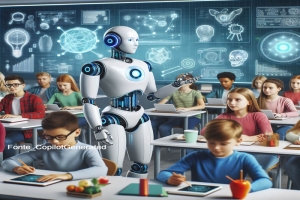 Carbajo-N˙˝ez MartÝn ,
AI & Education, (28.05.2024), (29),
in
Blog: www.cssr.news, 29-EN (2024) p. 2
.
Carbajo-N˙˝ez MartÝn ,
AI & Education, (28.05.2024), (29),
in
Blog: www.cssr.news, 29-EN (2024) p. 2
.
Artificial Intelligence (AI) systems have been used in various ways in the educational field: text editors, intelligent assistants, search algorithms, translators, etc.
On November 30, 2022, a qualitative leap occurred with the launch of ChatGPT, a generative AI program capable of "producing syntactically and semantically coherent texts." In just two months, the program reached over 100 million users. Quickly, many other applications that generate texts (Bing, Bard, YouChat, etc.), images (Dall-E, Midjourney, Leonardo, Jasper, etc.), audio, and videos were released to the market.
The growing use of these applications in the educational field is provoking both enthusiastic reactions as well as bewilderment: Should they be banned, or should students be helped to use them critically and creatively? How can possible plagiarism be identified and scientific rigor ensured in their schoolwork?
Pope Francis recognizes that "artificial intelligence systems can help to overcome ignorance and facilitate the exchange of information between different peoples and generations” (WCD 2024). At the same time, he warns that these systems can also “be a source of ‘cognitive pollution’, a distortion of reality” (WCD 2024, 7). A new cultural environment is being created that forces educational institutions to discern the "social and ethical aspects" and the "teaching and training methods." Above all, the Pope says, we must promote critical thinking, discernment, and a responsible use of data, so that pluralism and universal fraternity are reinforced (JMP 2024, 7).
Abundant Literature
The literature on AI and education is abundant. As early as 2015, the UN document on Sustainable Development (SDG4) encouraged the use of AI to serve quality education.[1] In the following years, UNESCO has continued this reflection.[2] Specifically, on November 23, 2021, UNESCO adopted a recommendation on the ethics of AI, which also focuses on education (point IV.8).[3] The European Commission has also published ethical guidelines on education and the training of educators in 2022
These and other documents call for AI algorithms to be transparent so that users can verify their criteria, objectives, and sources, thus reducing the risk of selective or discriminatory biases.
Challenges for Students
for the facilities it offers for gathering information and elaborating class assignments. There is concern that this may lead them to lose motivation to learn and increase the temptation of plagiarism. If they can get everything so easily, why bother making an effort? This can lead them to not develop creativity, critical thinking, and all those skills and competencies that are necessary for autonomous learning.
Challenges for Teachers
AI forces teachers to redefine their role and could threaten their job positions. Some of them fear that to become too dependent on technology that will require a great effort to use it appropriately. They regret not having the necessary resources to implement it in the classroom and are bewildered by the difficulty of detecting plagiarism and evaluating schoolwork.
Many others, however, perceive the great possibilities that AI offers, for example, to automate tasks, such as the correction of exams, and to provide personalized attention to students with special needs. Freed from some administrative duties, teachers can focus on interacting with students, lesson planning, and learning assessment. In addition, AI can quickly identify the difficulties each student encounters, thus helping to personalize the education.
Parents and educators must collaborate in synergy to enhance certain relational values, such as empathy, compassion, and fraternity, which can be overlooked in a technology-dominated environment.
A New Way of Understanding the Formative Task
The Church invites us to properly integrate AI into the educational task, facing its risks and enhancing its possibilities. Creativity and responsibility are needed rather than barriers and containment measures.
For its use to be effective, teachers must accompany students throughout the learning and research process. For example, to avoid the temptation of plagiarism, it may not be enough to carefully check completed assignments; it would be better to accompany students throughout the process of elaboration. Specifically, the teacher could encourage them to use AI as an initial resource and then discuss the results together in class.
Many proposals on how to use AI in class have already been published on the web. The debate continues, and we are all invited to participate in it.
Martín Carbajo-Núñez, ofm
Blog Alfonsiana: ("IA y Educación", online); Italiano (PDF - Online-CSSR), English (PDF – Online-CSSR); Español (PDF – Online-CSSR)
(Attached file) |
